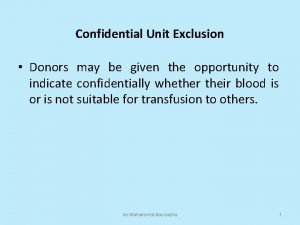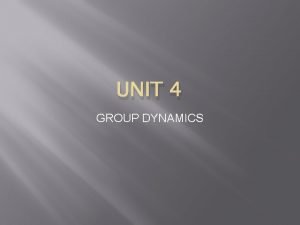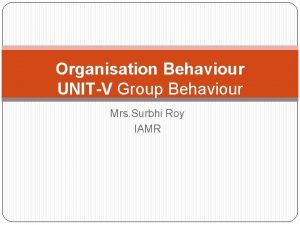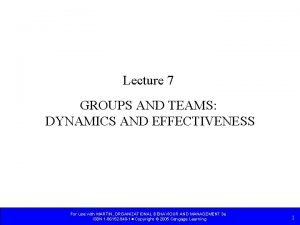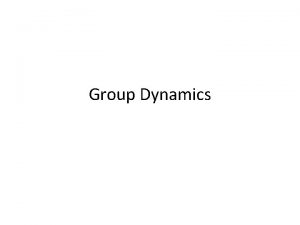Groups and Group Dynamics Unit 14 Confidential Definition















- Slides: 15

Groups and Group Dynamics Unit 14 Confidential

Definition of Group • Kimball Young defines a group as: "two or more persons in a state of social interaction. " • According to T. M. Newcomb : 'a group consists of two or more persons who share norms about certain things with one another and whose social roles are closely interlocking. ' Confidential

Characteristics of a Group 1) Two or more people, 2) who interact with one another, 3) share some common ideology, 4) see themselves as a group. Confidential

Purposes Served by Groups 1. An outlet for affiliation needs i. e. needs for friendship, support and love. 2. A means of developing, enhancing or confirming a sense of identity and maintaining self-esteem. 3. A means of establishing and testing reality through developing consensus among group members, uncertain parts of social environment can be made "real" and "stable. ” Confidential

Purposes Served by Groups 4. A means of increasing security and sense of power of coping with a common and powerful enemy or threat. 5. A means of getting same job done that members need to have done: Such as gathering information or helping out when some are sick or tired or avoiding boredom and providing stimulation to one another or bringing new members of the organisation quickly into the informal structure. Confidential

The Types of Groups • Formal • Informal Confidential

Fundamental Characteristics of Groups 1. Have leaders; 2. Have followers; 3. Strive toward some goal or goals; 4. Have ideas about what it takes to achieve the goals; 5. Communicate expectations to members; 6. Satisfy some form of member needs. Confidential

The Characteristics of Formal Work Groups 1) they are sanctioned by some authority; 2) there is a prescribed division of labour 3) individuals are assigned specific responsibilities, 4) there are stable and consistent personal interactions, and 5) provisions are made for rewarding the group membership. Confidential

The Characteristics of Informal Work Groups • Informal groups are loosely organized groups such as bowling teams and social clubs that arise apart from the formal organization to which members of the informal group may belong. • From the perspective of the worker, informal work groups provide a source of satisfaction for security needs, social needs, and esteem needs. Confidential

Elements of ‘Group Behaviour' • • Membership in the Group Emergent Leadership Formal Hierarchy Group Has Some Activity or Task to Perform • Interaction • Group Norms – Group Cohesiveness – Member Satisfaction Confidential

Group Decision-making • Most big decisions in organizations are made by groups rather than individuals. Even if a group of people does not formally sit together to thrash out a decision, several people usually provide input to any major decision. Confidential

Group Dynamics • Thomas Harrell has defined group dynamics as: “an expression that describes the situation in which people acting together in a group accomplish certain thing, either positively or negatively in a way that cannot be explained adequately in terms of the individual acting separately. ” Confidential

Principles of Group Dynamics 1. If a group is to be used effectively as a medium of change, those who are to be changed and those who are to wield an influence for change must have a strong sense of belonging to the same group. 2. The more attractive a group is to its members, the greater the influence it would exercise on its members. Confidential

Principles of Group Dynamics 3. The higher the prestige of a group member in the eyes of other members, the greater the influence he will exercise on them. 4. Successful efforts to change individuals or sub-parts of a group would result in making them conform to the norms of the group. 5. Strong pressure for changes in a group can be established by creating a shared perception by members for the need for change. Confidential

Principles of Group Dynamics 6 Information relating to the need for change, plans for change, and the consequence of change must be shared by all the members of a group. 7 Changes in one part of a group produce a strain in other related parts which can be reduced only by eliminating the change or by bringing about readjustments in the related parts. Confidential
 How are ethnic groups and religious groups related
How are ethnic groups and religious groups related Group dynamics definition
Group dynamics definition Group dynamics definition
Group dynamics definition Group dynamics nature
Group dynamics nature Confidential unit exclusion
Confidential unit exclusion Maypole interaction pattern
Maypole interaction pattern Group dynamics and communication
Group dynamics and communication Group processes and dynamics
Group processes and dynamics Autokinesis
Autokinesis Group leaders of reality therapy groups are
Group leaders of reality therapy groups are Dynamics crm user group
Dynamics crm user group Nature of an organization
Nature of an organization What is group dynamics in organisational behaviour
What is group dynamics in organisational behaviour Group dynamics in organisational behaviour
Group dynamics in organisational behaviour Bion group dynamics
Bion group dynamics Tiwari groups
Tiwari groups




